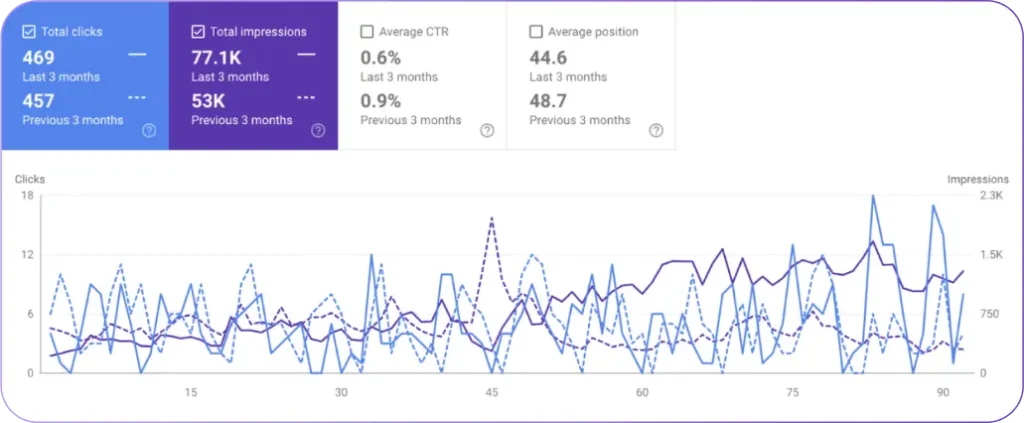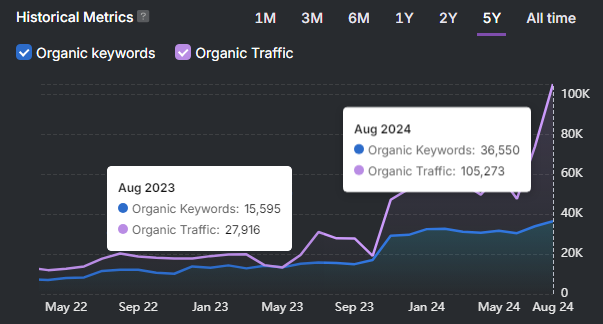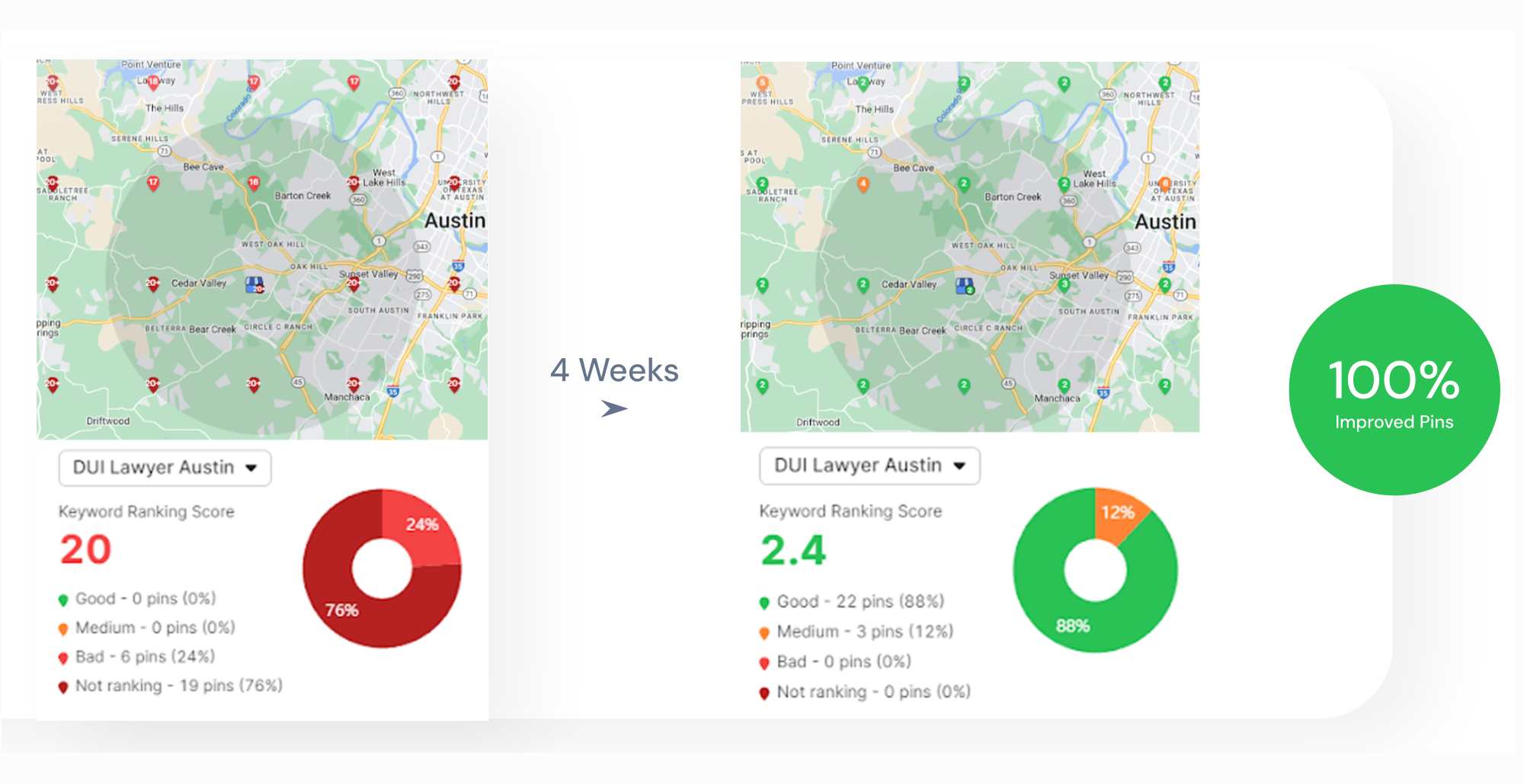SEO for finance is the process of improving the visibility of financial services websites in search engine results, with a strong emphasis on trust, compliance, and content accuracy. Whether it’s a bank, fintech platform, financial advisor, or insurance provider, SEO helps financial brands connect with users who are actively searching for solutions that impact their money, credit, or investments.
Because finance is considered a YMYL (Your Money or Your Life) category by Google, ranking in this space demands more than basic keyword optimization. Search engines evaluate the trustworthiness of your content, the expertise of your authors, and how well your site complies with strict data and security standards.
Getting SEO right in the financial industry means aligning your digital presence with what users and search engines expect from high-stakes services. This guide explains what makes financial SEO unique, why it matters, and how to develop a strategy that enhances rankings, promotes credibility, and generates high-quality leads.
What Is SEO for Finance?
SEO for finance is the practice of increasing the visibility of financial services websites in organic search results to attract more qualified leads and clients. SEO for finance involves optimizing your website and content so that it ranks for keywords that potential customers are searching for. Examples of such keywords include “mortgage broker,” “retirement planning,” or “business loan requirements.”
There would be another paragraph here that includes what is in the list. It would start like “Effective SEO for finance includes creating expert-led content…” (continue with the list, but in paragraph format).
Financial SEO requires strict attention to content quality, regulatory compliance, and trust-building elements. Economic decisions carry high stakes; both users and search engines hold finance websites to a higher standard of accuracy, security, and authority.

Why Does SEO Matter in Financial Services?
SEO plays a vital role in helping financial services connect with potential clients who are actively searching for trusted solutions. Ranking well in search results directly influences decision-making and determines whether you gain or lose business in a field where credibility and visibility are paramount.
There are different reasons why SEO matters for financial services. There are different reasons why SEO matters for financial services are listed below.
- Increased Visibility and Qualified Traffic: SEO ensures your business appears for the right keywords, attracting users who are already interested in the services you offer.
- Trust and Brand Authority: Publishing helpful, accurate content builds credibility and positions your brand as a reliable financial resource.
- Cost-Effective Client Acquisition: Compared to paid ads, SEO delivers consistent organic traffic over time without ongoing ad spend.
- Competitive Advantage: Many finance brands still underinvest in SEO. A focused strategy helps your business outperform slower-moving competitors.
- Mobile and Technical Optimization: SEO encourages fast, mobile-friendly SEO, secure websites, which are essential for user experience and customer retention.
- Google’s E-E-A-T Standards: In the finance sector, Google rewards content that demonstrates expertise, authority, and trustworthiness, making SEO a trust-building tool as much as a visibility tactic.
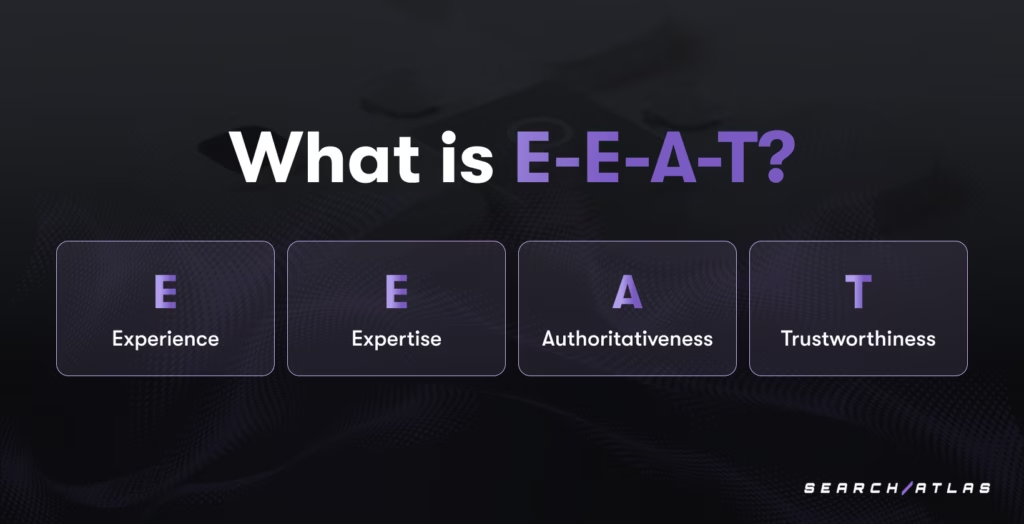
What Are the Differences Between General SEO and SEO for Finance?
Traditional SEO and financial SEO share the same foundation in improving organic visibility. But they diverge in complexity, risk, and expectations. Financial SEO operates under stricter search engine scrutiny because it’s classified as “Your Money or Your Life” (YMYL) content, where accuracy, expertise, and trustworthiness are essential.
In general industries, SEO focuses on volume and broad visibility. In finance, every piece of content, keyword, and backlink must meet higher standards of compliance, reliability, and user safety. Ranking isn’t enough. Your website must prove it deserves to rank.
Search engines place financial websites under closer review to protect users from misinformation, scams, or unsafe advice. Finance brands must offer secure platforms, credible content, and transparent business practices to meet this higher standard.
Key Differences Between Traditional SEO and SEO for Finance
| Feature | Traditional SEO | SEO for Finance |
| Content Type | General topics with lower stakes | YMYL content with legal and financial implications |
| E-E-A-T Requirements | Important but less enforced | Critical, with a need to show expertise, authority, and trust |
| Compliance Needs | Minimal or industry-specific | Must follow financial regulations such as the SEC, FCA, or FINRA |
| Content Creation | SEO-focused blogs and general guides | Expert-written content that is accurate and regulation-compliant |
| Keyword Targeting | Broad search intent and topics | Highly specific and intent-driven financial keywords |
| User Trust Signals | Helpful but not essential | Essential, including HTTPS, visible credentials, disclaimers, and privacy terms |
| Backlink Profile | General authority and niche relevance | High-authority backlinks from trusted financial sources |
| UX Expectations | Fast and usable websites | Secure, professional, and seamless user experience |
| Risk Level | Low to moderate | High, with strict consequences for inaccuracy or misrepresentation |
| Search Engine Scrutiny | Standard algorithm review | Extra algorithmic checks for legitimacy, accuracy, and compliance |
10 Effective SEO Strategies For Financial Services
SEO for financial services is about more than visibility. It requires a strategy that builds authority, meets compliance standards, and targets the right audience with precision. Financial brands must earn trust while competing in a high-stakes, highly regulated environment.
There are 10 SEO strategies for financial services. The 10 SEO strategies for financial services are listed below.
1. Perform a Content Audit
A content audit is the process of reviewing all the existing pages on your website to assess their performance, relevance, and alignment with SEO goals. For financial services, a content audit means analyzing whether your content is accurate, up-to-date, compliant, and targeting the right keywords.
In finance, outdated or low-quality content damages trust and triggers compliance issues. A thorough content audit helps you identify gaps, remove underperforming pages, and optimize content that isn’t ranking or converting. It ensures that everything on your site contributes to visibility, credibility, and user satisfaction.
There are 5 steps to perform a content audit. The steps to perform a content audit are listed below.
- Inventory all content on your website using a tool like the Search Atlas Site Auditor.
- Evaluate each page based on traffic, bounce rate, backlinks, and keyword rankings.
- Check for outdated information, thin content, or duplicate pages.
- Flag content that needs to be updated, consolidated, redirected, or deleted.
- Prioritize updates for pages targeting YMYL keywords or financial topics with high search intent.
A good content audit is both strategic and precise. It goes beyond traffic metrics to assess how well your content builds trust, meets business goals, and matches user intent. In finance, that means aligning pages with E-E-A-T, compliance, and conversion best practices.
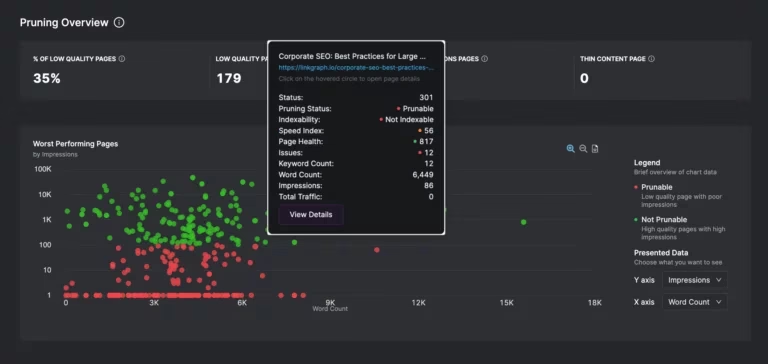
Use Search Atlas Site Auditor tool to identify weak pages, uncover technical or content issues, and offer clear steps to improve SEO and user trust.
2. Conduct Keyword Research
Keyword research involves finding and analyzing the search terms that your target audience uses when looking for financial products or services online. Keyword research includes understanding search volume, competition, and the underlying user intent behind each query.
Choosing the right keywords is essential for financial SEO. You need to target terms that are both high-value and compliant with industry regulations. Pairing the right keywords with user intent ensures that your content attracts and resonates with qualified prospects who are ready to convert.
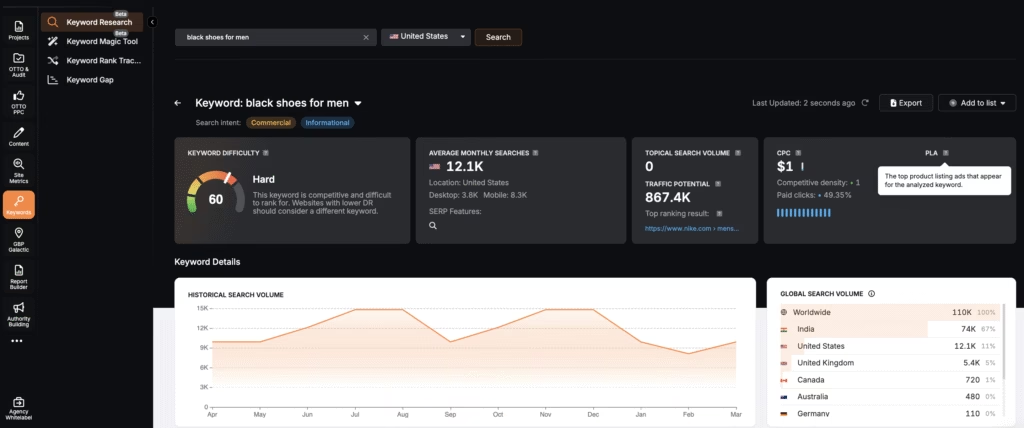
There are 5 steps to conduct keyword research. The steps to conduct keyword research are listed below.
- Brainstorm core finance topics such as “mortgage refinancing,” “retirement strategy,” or “small business loan”.
- Use tools like Google Keyword Planner or Search Atlas to gather search volume, keyword difficulty, and competition data.
- Analyze intent, informational, transactional, and navigational to tailor content appropriately.
- Prioritize keywords with strong intent, relevant search volume, and manageable competition.
- Cluster related keywords to build topic-focused content rather than targeting standalone terms.
- Keep an eye on long-tail phrases that match nuanced financial queries and often convert better.
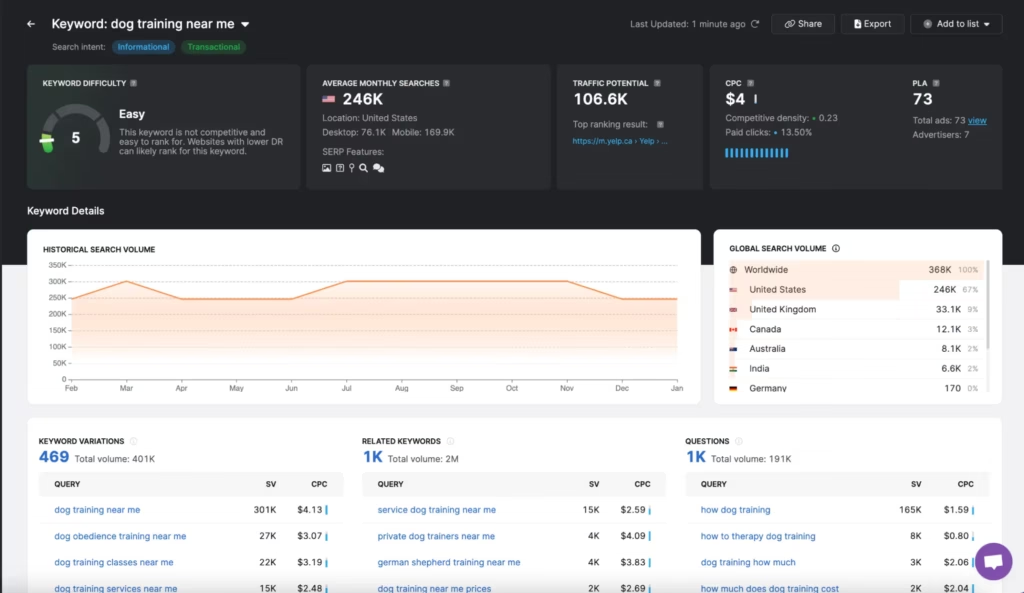
Use the Search Atlas Keyword Research Tool to enter a seed keyword and generate related terms with volume, difficulty, and intent. Filter by country or SERP feature. Sort by traffic potential. Export lists to fill content gaps and guide strategy.
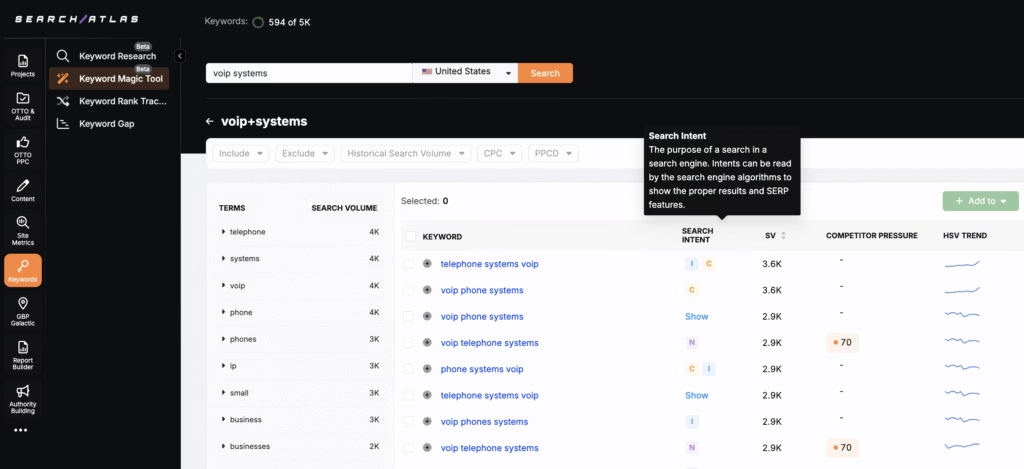
Use the Search Atlas Keyword Magic Tool to expand ideas around a core topic. Explore grouped suggestions by theme. Filter for questions, long-tail terms, or local intent. Build keyword clusters that support specific goals and improve topical relevance.
Use the Search Atlas Content Planner to group keywords into clusters, assign target URLs, and schedule content. Track optimization progress and align each cluster with user intent. Use this tool to build a structured, keyword-focused content roadmap.
3. Create High-Quality Content
Creating high-quality content means producing accurate, relevant, and valuable information that answers your audience’s financial questions. This includes blog posts, landing pages, service descriptions, guides, calculators, videos, and more. Each piece is crafted to educate, inform, or support your users.
In the financial space, content quality is not just a ranking factor. It is also a trust factor. Since financial topics fall under Google’s YMYL (Your Money or Your Life) category, content must meet a higher standard of accuracy, clarity, and authority. Quality content helps demonstrate Google E-E-A-T (Experience, Expertise, Authoritativeness, and Trustworthiness), which is critical for ranking and credibility.
There are 5 steps to create high-quality content for financial services. The 5 steps to create high-quality content for financial services are listed below.
- Start with keyword research to identify what your audience is searching for.
- Choose topics that align with user intent and your business goals.
- Collaborate with subject-matter experts to ensure accuracy and compliance.
- Write clearly and concisely, avoiding jargon unless it is necessary and explained.
- Include visual elements like charts, calculators, or infographics to support understanding.
- Structure content using headings, bullet points, and short paragraphs for better readability.
- Regularly update existing content to reflect the latest regulations, rates, or market trends.
Effective financial content is grounded in clarity, compliance, and value. It anticipates user concerns, builds confidence through transparency, and provides actionable insights. Genuinely helping users make informed decisions earns engagement, links, and rankings for quality content, whether it targets beginners or seasoned investors.
4. Follow On-Page SEO Best Practices
On-page SEO involves optimizing individual pages to improve their search rankings and user experience. On-page SEO includes enhancing titles, meta descriptions, headings, URLs, internal links, keyword placement, and content formatting.
For financial services, every page must be clear, technically sound, and trustworthy. Search engines rely on these elements to understand your content’s relevance. Strong on-page SEO, combined with quality content and technical SEO, improves your chances of ranking well for competitive financial keywords.
There are 8 steps to apply on-page SEO best practices. The 8 steps to apply on-page SEO best practices are listed below.
- Use your target keyword in the page title, preferably near the beginning of the title.
- Write compelling meta descriptions that include the keyword and encourage users to click.
- Organize content using heading tags (H1, H2, H3) that follow a logical hierarchy.
- Keep URLs short, clean, and keyword-rich.
- Place keywords naturally within the content, without overstuffing.
- Add internal links to relevant pages to help users navigate and spread link equity.
- Use alt text on images to improve accessibility and keyword relevance.
- Ensure the page is mobile-friendly and loads quickly.
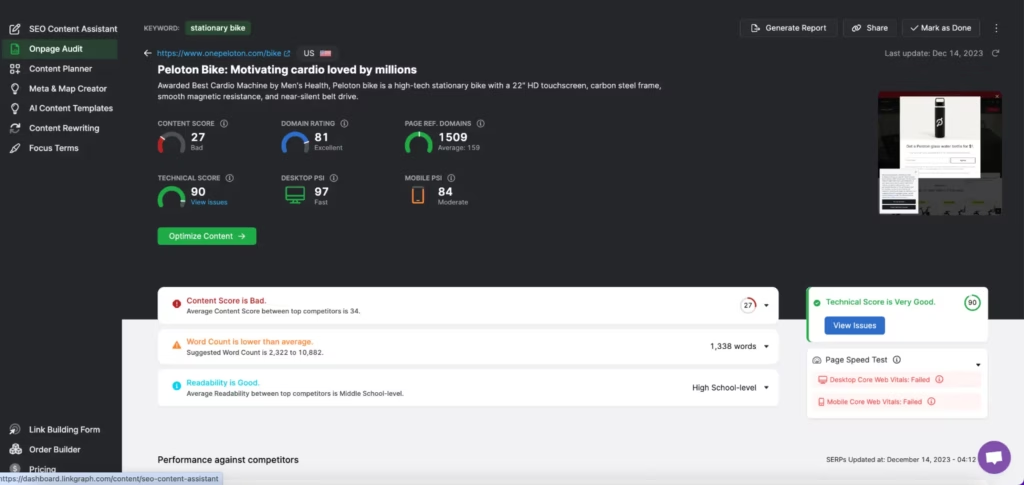
Use Search Atlas On-Page Audit to identify areas that need improvement, helping you maintain clear, optimized pages that perform well in search and build user confidence in a highly competitive industry.
5. Run a Technical SEO Audit
A technical SEO audit is a detailed evaluation of your website’s backend elements that affect how search engines crawl, index, and rank your pages. Technical SEO includes checking for issues related to site speed, mobile responsiveness, security, crawlability, indexability, and structured data.
In financial services, your site must meet higher standards for performance, trust, and usability. Technical problems prevent search engines from accessing your pages or create poor user experiences that drive visitors away. A clean, optimized site infrastructure supports higher rankings and ensures compliance with SEO best practices.
There are 6 methods to run a technical SEO audit. The 6 methods to run a technical SEO audit are listed below.
- Check for crawl errors, broken links, and redirect issues.
- Optimize page speed by compressing images, minimizing JavaScript, and enabling caching.
- Ensure the site is mobile-friendly with a responsive design. Mobile friendliness is very important, as Google now primarily uses its Mobile Googlebot as its default crawler since July 5, 2024.
- Use HTTPS to protect user data and meet Google’s security standards.
- Review your robots.txt and XML sitemap files for accuracy and completeness.
- Identify and fix duplicate content issues.
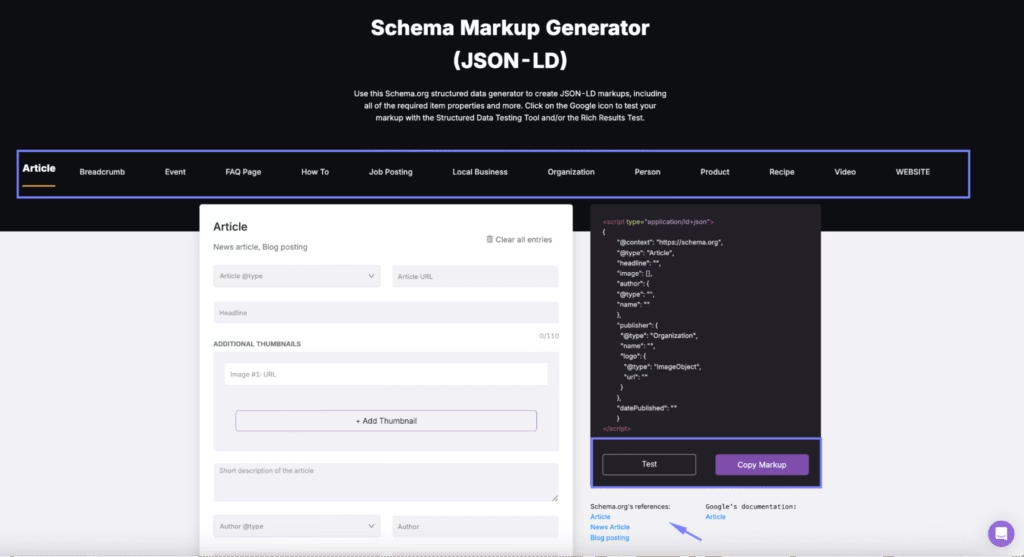
- Implement structured data (schema markup) to help search engines understand your content.
- Use author schema markup to identify content creators, which is vital for YMYL topics where Google assesses expertise and trustworthiness.
- Ensure proper use of canonical tags to avoid indexing problems.
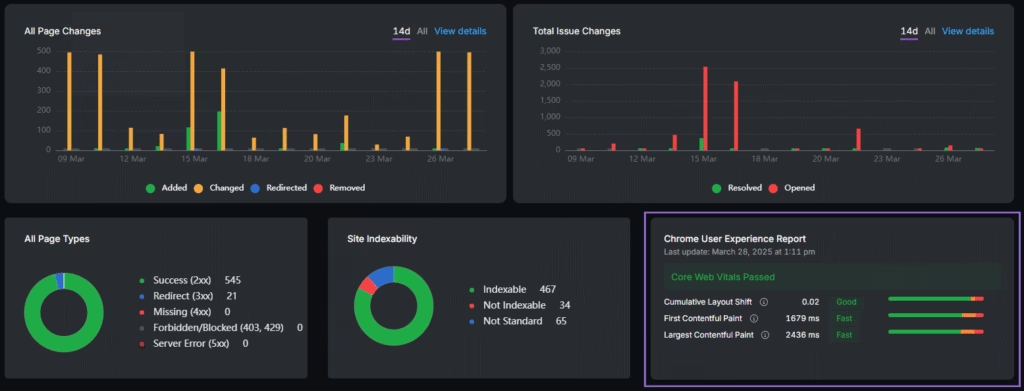
- Monitor your Core Web Vitals in Search Atlas Audit tool.
A thorough technical audit guarantees that search engines fully access, interpret, and rank your website. In finance, where performance, security, and trustworthiness are critical, a technically sound site provides the foundation for all other SEO efforts. Including author schema is especially important, as Google tracks author identity and expertise to evaluate content quality on YMYL pages.
6. Optimize for Local SEO
Local SEO focuses on improving your online visibility within a specific geographic area. For financial services like banks, insurance agencies, or advisory firms, appearing prominently in local searches is crucial. Visibility in Google’s Local Pack is a key driver of foot traffic and qualified leads.
Many consumers use search engines to find nearby financial professionals, using queries like “financial advisor near me” or “townbank mortgage branch.” Ranking locally enhances credibility and builds trust within the community. It also differentiates you from larger, non-local competitors.
There are 8 methods to optimize for local SEO. The 8 methods to optimize for local SEO are listed below.
- Claim and fully optimize your Google Business Profile (GBP) with accurate business details.
- Ensure consistent NAP (name, address, phone) across all online listings and directories.
- Use city or region-specific keywords naturally in titles, meta tags, headings, and content.
- Use structured data markup for local business information to help search engines understand your location.
- Encourage and respond to customer reviews to boost engagement and signal trust.
- Build backlinks from nearby sources like local news outlets, business associations, or chamber of commerce websites.
- Ensure your site is mobile-friendly and fast, as many local searches happen on mobile devices.
- Track location-based rankings and citations to quantify your local SEO impact.
Local SEO builds visibility and authority exactly where clients are searching. Search Atlas’s Local SEO tools, like GBP management, citation builder, and heatmap tracking, help you manage and optimize these elements at scale. By combining accurate business info, local content, and strategic links, your financial service dominates local search and establishes strong community trust.
7. Build Backlinks
In finance, backlinks matter more because Google applies stricter standards around E-E-A-T. In January, Google clarified that low-quality content rewritten from authoritative sources, often by AI, is considered among the lowest quality.
To meet expectations, financial content must be original, accurate, and insightful. Referencing reputable sources or including expert quotes is acceptable, but your content must offer unique value. Earning high-quality backlinks from trusted financial or local sites supports that originality and strengthens your authority in competitive search results.
There are 9 steps to build backlinks. The 9 steps to build backlinks are listed below.
- Publish original, high-quality content that adds value and is worth linking to.
- Include expert insights, data, or unique analysis to increase linkability.
- Reach out to finance blogs and publications for guest posting or citations.
- Submit your business to authoritative directories or financial associations.
- Reclaim unlinked brand mentions by turning them into backlinks.
- Partner with local events or sponsorships to earn geo-relevant links.
- Monitor competitor backlinks to discover new link opportunities.
- Use OTTO WILDFIRE to automate outreach and secure vetted link placements.
- Track link health and anchor usage to maintain a clean and effective link profile.
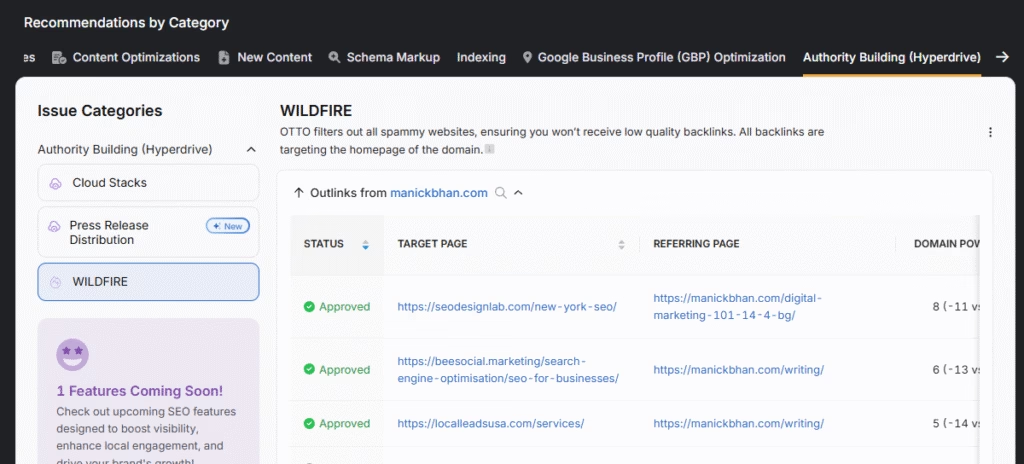
Use Search Atlas OTTO WILDFIRE to automate link building through a 2:1 vetted exchange. The tool finds authoritative, locally relevant sites, manages outreach, and places links while monitoring anchor usage and link health. For finance, OTTO WILDFIRE offers scalable, trustworthy backlink acquisition without compromising credibility or compliance.
8. Analyze Your Competitors
Competitor analysis involves studying the SEO strategies of other financial websites that rank well for your target keywords. This gives you insight into what works in your niche, helping you uncover gaps, identify opportunities, and refine your own approach to outperform them in search results.
In finance, where many established brands compete for attention, knowing what your competitors are doing saves time and sharpens strategy. You discover the types of content they prioritize, the keywords they target, the backlink sources they rely on, and how they structure their websites for SEO success.
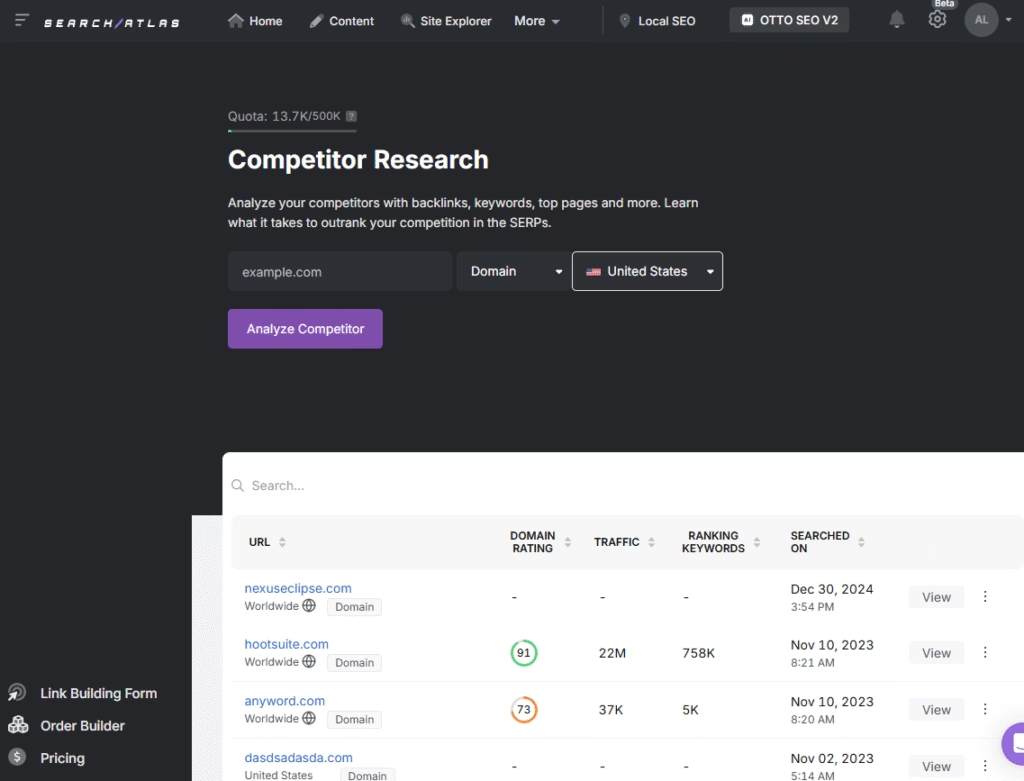
There are 6 methods to analyze the competitors. The 6 methods to analyze the competitors are listed below.
- Identify your top-performing competitors by searching target keywords and noting who consistently ranks
- Use tools like Search Atlas to compare keyword overlap, content quality, and topical gaps
- Study their backlink profiles to find potential link opportunities for your site
- Analyze their site structure, URL hierarchy, and internal linking to inform your own
- Track changes in their rankings and content updates to stay current with their strategies
- Evaluate their page load speed, mobile usability, and technical health
Competitor analysis is about using insights to build a smarter, more differentiated strategy. Search Atlas helps reveal where your content or backlink profile falls short, helping you close gaps and seize ranking opportunities in a competitive financial market.
9. Improve Your E-E-A-T
E-E-A-T stands for Experience, Expertise, Authoritativeness, and Trustworthiness. E-E-A-T factors are critical in financial SEO, especially for YMYL content, where Google places high importance on the reliability and credibility of information. Improving E-E-A-T helps establish your brand as a trusted source, increasing user confidence and boosting your search rankings.
In January, Google updated its guidelines to crack down on low-quality AI content that simply rewrites well-known sources. For finance, your content must be original and relevant. Quoting trusted sources is fine, but avoid just rehashing existing material. Deliver unique insights and real expertise to meet Google’s standards and stand out in search results.
There are 7 steps to improve the E-E-A-T of a website. The 7 steps to improve the E-E-A-T of a website are listed below.
- Showcase author credentials by including detailed bios and qualifications.
- Use author schema markup to highlight expertise and improve content credibility.
- Publish content that demonstrates real experience and deep knowledge of financial topics.
- Obtain backlinks from authoritative industry websites and financial institutions.
- Maintain accurate, up-to-date information to comply with regulatory standards.
- Encourage positive customer reviews and testimonials that reinforce trust.
- Ensure your website is secure, transparent, and user-friendly.
Strong E-E-A-T signals are essential for building trust with both users and search engines. For financial services, where accuracy and integrity are paramount, a focus on E-E-A-T supports compliance and positions your site as a dependable resource. Search Atlas tools assist by helping you audit author markup and monitor backlink quality to uphold your E-E-A-T standards.
10. Track and Measure SEO Performance
Tracking and measuring SEO performance is essential to understand how your efforts impact your website’s visibility, traffic, and conversions. In financial services, where every lead and conversion matters, monitoring key SEO metrics helps you optimize strategies, allocate resources efficiently, and ensure compliance with industry standards.
There are 11 steps to track and measure SEO finance performance.The 11 steps to track and measure SEO finance performance are listed below.
- Define clear SEO goals such as increasing organic traffic, improving keyword rankings, or boosting conversions.
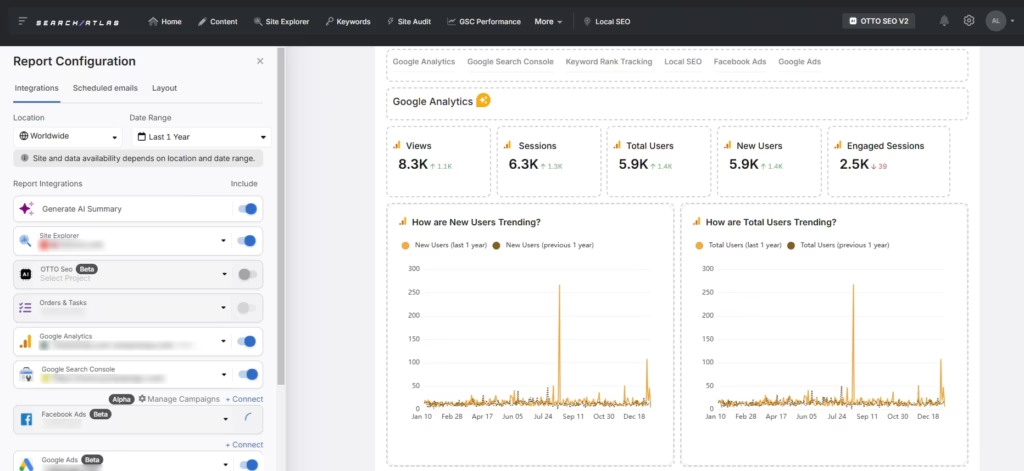
- Use Google Analytics (GA4) to analyze visitor behavior, traffic sources, and conversion data.
- Monitor keyword rankings and search visibility through tools like Google Search Console.
- Track click-through rates to assess how compelling your search snippets are.
- Analyze referring domains to evaluate backlink growth and authority.
- Check indexed pages and identify index coverage issues to ensure search engines crawl your site effectively.
- Regularly review organic conversions to measure SEO’s impact on business goals.
- Use Search Atlas for deeper audits, backlink analysis, and competitor insights.
- Review your data consistently to spot trends and identify areas needing improvement.
- Adjust your SEO strategies based on data insights to maintain or improve performance.
- Stay updated with SEO best practices and Google algorithm changes to keep your approach relevant.
Ongoing SEO performance tracking enables financial services businesses to make informed decisions and refine campaigns for sustained growth. Search Atlas tools streamline monitoring by integrating key metrics into one platform, helping you maintain visibility and compliance in a competitive market.
What Are Some Challenges in SEO For Finance?
SEO for finance comes with distinct complexities that make it more demanding than traditional optimization efforts. Financial websites are held to higher standards by both users and search engines. From regulatory compliance to content quality and technical execution, success in this space requires precision, expertise, and adaptability.
There are different challenges in finance SEO. The different challenges in finance SEO are listed below.
- Regulatory Compliance: Financial websites must comply with strict regulations enforced by authorities such as the U.S. Securities and Exchange Commission (SEC), the U.K. Financial Conduct Authority (FCA), or the Australian Securities and Investments Commission (ASIC).
- Content Accuracy, Quality, and YMYL Sensitivity: Financial topics fall under Google’s “Your Money or Your Life” (YMYL) category, which means inaccurate or misleading information directly impacts a user’s financial security.
- High Competition: The financial vertical is saturated with legacy banks, fintech startups, investment platforms, and lead-generation sites all targeting the same high-value keywords. Standing out requires more than foundational SEO. It demands strong domain authority, strategic backlink acquisition, and highly relevant content that matches user intent.
- Technical SEO Complexity: Finance sites often contain user portals, calculators, quote engines, or interactive tools, which create barriers to crawlability and rendering. Technical SEO must ensure clean site architecture, fast page speeds, HTTPS security, and structured data that helps search engines understand and trust the content.
- Managing International SEO: Global financial services must handle multi-country operations with different compliance requirements, tax systems, and currencies. Implementing proper hreflang tags, building localized content, and aligning with region-specific regulations are essential for international visibility and legal safety.
- Keeping Up with Algorithm Changes: Google continues to evolve its algorithms, particularly around YMYL and E-E-A-T. Financial websites must adapt quickly to changes while ensuring their content, UX, and compliance measures remain intact. Staying ahead requires constant monitoring, regular audits, and agile SEO operations.
What Is The Role of Compliance and Data Privacy In Financial SEO?
In financial SEO, compliance and data privacy are not optional; they are essential to both visibility and credibility. Financial institutions must follow strict regulations set by authorities like the SEC, FCA, or ASIC. These rules influence how services are presented, what language is used, and how financial risks must be disclosed.
Content must be fact-checked, transparent, and legally sound, which often means involving legal teams in SEO workflows. This level of scrutiny directly supports Google’s E-E-A-T criteria, especially in the finance niche where expertise and trust are key to ranking.
Data privacy is another core requirement. Financial websites frequently collect sensitive user information through forms, logins, and transaction pages. Complying with laws like GDPR, CCPA, or LGPD is critical, not to avoid legal penalties but to retain user trust. Search engines reward sites that are secure and transparent. Using HTTPS, cookie consent banners, and clear privacy policies contributes to higher user engagement and lower bounce rates, both of which influence SEO performance.
Strong technical foundations also matter. Google favors websites that are safe, fast, and mobile-friendly, especially in YMYL (Your Money or Your Life) industries. A well-secured site shows users and search engines that your business takes privacy seriously. In this space, SEO success depends on building trust before anything else.
What Is More Important in SEO for Finance?
Financial SEO is about more than rankings. It’s about trust, credibility, and compliance. In an industry where Google applies heightened scrutiny and users expect precision, your SEO strategy must prove that your content is relevant, accurate, and created by real experts. It’s not enough to publish frequently. You need to publish responsibly, following E-E-A-T principles and tailoring every technical, on-page, and content decision to the demands of a YMYL category.
The strategies in this guide provide a clear and measurable way to achieve that. From conducting content audits to improving your site’s technical foundation, building backlinks, and enhancing author visibility, every method contributes to stronger authority and discoverability. More importantly, it helps you earn the kind of trust that drives meaningful action from newsletter signups to investment inquiries.
Search Atlas brings that trust-building process into a simplified and scalable workflow. With tools like the Site Auditor, On-Page Audit Tool, OTTO WILDFIRE, and Content Planner, you optimize, publish, and promote financial content that ranks and resonates.
Ready to strengthen your SEO foundation and grow with confidence? Start your Search Atlas free trial!
Title Page Separator Site title
Learn effective SEO for finance to boost rankings, build trust, ensure compliance with content, links & technical best practices.








